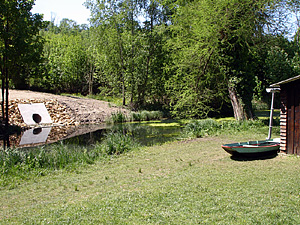
| Home page Installations Exhibiitions Editions Projects Invitations Biography Texts Links ContactFor a Landscape of Water Publics Benches The Fallen Tree Collateral Gains At the end ot the tunnel / Grotesque / Documentary The Sand Quarry in the Mangrove Swamp The Landing Place Converstation on Rainy Days The Carter The Foutain The Waste land Carbolux The Camp of l'Ermitage The Barque Long-viiew-la-Masure 14 Benches face à face Balance The Home of Alders + Bruni/Babarit's Website |
two
fountains... "Les Environnementales 2008" 5th Contemporary Art Biennal in Open Sky Park of the CCIP, Jouy-en-Josas, Yvelines, France Context A place, near the shed where MAJOR BUSINESS SCHOOLS lined up its canoes, not very far from the cave where was located the ancient sideboard of water in the XVIIth century. Materials: Gutter and descent pvc, small boat prepared for the emulsion bitumeuse, existent buzzard, rainwater, noise of cataract, two persons with a strong visual sense drawn in throw of ink taken up on contreplaqués panels and half rafters. Device: gutter and descent in PVC taken up on the shed, small boat prepared for the emulsion bitumeuse to receive waters of rain; band of plants cut at the edge of the man-made lake; opposite, clarified by accesses of the buzzard; two panels put down on both sides by the shed with texts and picture. Dimensions of in situ: 18 m (L) x 25 m (l) x 3,5 m (h). Collaboration: Sylvain, Quentin, Laurent Roman, Loïc and Arthur, students in LOW VOLTAGES AP2; teaching Corinne Meynial, landscapist; material Christian Calin, service TP; Joël Landrin, joiner; Mathieu, student in L2 Plastic arts; Galaad Prigent and editions Zédélé. Un lieu, près du hangar où HEC rangeait ses canoës, pas très loin de la grotte où était situé l’ancien buffet d’eau au XVIIe siècle. Edition A publication produced with the installation is appeared to editions Zédélé to accompany the installation. [ Read more ] Commentary Conversation on rainy days: two fountains. From TECOMAH, Jouy en Josas, les Environnementaies 2008 Water has become a precious and rare material which seeks to be watched. Mastering water is a human ambition, the artificial park water feature being the most obvious example of this. However its circulation is most often out of sight, the poetic dimension hidden by technicians. Gilles Bruni works by surveying and repairing a site before his pieces take shape within it. He has followed the aformentioned theme of water in this installation. On the bank at the foot of the slope there is a pipe of rejected water flowing out of an enormous 'gob' as the artist likes to call it, happy to borrow the ancient name from the hydrant men. Its design, its geometry, its appearance of something brought back into the landscape and the intriguing effect of this great black mouth opening from the unknown depths of the earth, all make this anti-sculpture captivating, to the point that the artist leaves it untouched. In a fragile and restrained way he brings the visiter to ponder upon it, to interact with it directly, which is quite a contrast to the site itself. In using the words two 'fountains' Gilles unites the two parts of this work in terms of functional equality, but in doing so actually underlines the contrast between them. The other title words rainy days represent the gutter that extends from the old shed which feeds into the old rowing boat. This will in fact never be more than a trickle of water - a very strange pool, a boat whose function has been turned on its head. Organised in false parralel with one another, this inversion of elements pushes visitor to take a moment to reconsider between what they had expected from the site and what actually is. This is how Gilles Bruni works, not by imposing himself upon the landscape but by slipping into it. Something stops him in his tracks, often it's a sign of human handiwork, a link to the past, a witness or a memory. Building upon the item that he has found he imaginatively extends and transforms the initial element into a construction or organisation of some sort. In this way his work combines context, signs and memory. It speaks as much about time as history, space, mans work, conflict and complicity. Water will always flow wherever it wants, even if he has told it where to. This intervention of the artist holds onto a temporary existence which serves to sharpen the experience of his chosen site. Cristophe Domino Art Critic |
 [ + ] |
|
